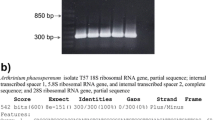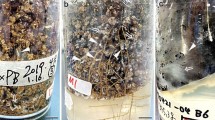Summary
In paired cultures with two mycorrhizal fungi, the root pathogen Cylindrocarpon destructans (Zinsm.) Scholten had an inhibitional effect on mycelial growth of Laccaria laccata (Scop, ex Fr.) Bk. & Br. but was inhibited itself by Paxillus involutes (Batsch.) Fr. A similar pathogen-symbiont interaction scheme was observed in triaxenic cultures with Picea abies Karst. seedlings but only in the vicinity of the mycorrhizal root tips. Both mycorrhizas similarly increased the endogenous plant resistance against the infection of C. destructans. This suggests that direct pathogen-symbiont interactions are an important factor for population dynamics in the mycorrhizo sphere. Moreover, endogenous plant resistance constitutes one of the key factors for an effective defence against pathogenic fungi.
Similar content being viewed by others
References
Bérdy J (1981) CRC Handbook of antibiotic compounds. II. macrocyclic lactone antibiotics. CRC Press, Boca Raton, pp 445–449
Betina V, Murin M (1964) Inhibition of mitotic activity in root tips of Vicia faba by the antibiotic cyanein. Cytology 29: 370–374
Bowen GD (1980) Misconceptions, concepts and approaches in rhizosphere biology. In: Contemporary microbiology and ecology. Academic Press, New York, pp 283–304
Chalot M, Battut PM, Botton B, Letacon F, Garbaye J (1988) Recent advance in physiological and practical aspects of ectomycorrhizal effects on tree development. Acta Oecol 9: 333–351
Chakravarty P, Unestam T (1986) Mycorrhizal fungi prevent disease in stressed pine seedlings. Phytopathology 118: 335–340
Cook R, Baker KF (1983) The nature and pratice of biological control of plant pathogens. Am Phytopathol Soc, St. Paul
Duchesne LC, Peterson RL. Ellis BE (1988) Interactions between the ectomycorrhizal fungus Paxillus involutus and Pinus resinosa induces resistance to Fusarium oxysporum. Can J Bot 66: 558–562
Duchesne LC, Ellis BE, Peterson RL (1989) Disease suppression by the ectomycorrhizal fungus Paxillus involutus, contribution of oxalic acid. Can J Bot 67: 2726–2730
Evans G, Cartwright JB, White NH (1967) The production of phytotoxin, nectrolide by some root surface isolates of Cylindrocarpon radicola Wr. Plant Soil 26: 253–260
Farquhar ML, Peterson RL (1990) Early effects of the ectomycorrhizal fungus Paxillus involutus on the root rot organism Fusarium associated with Pinus resinosa. Can J Bot 68: 1589–1596
Forbrig R (1987) Anatomische und histologische Untersuchungen an pilzinfizierten Fichtenkeimlingen (Picea abies Karst.). Allg Forst Jagdztg 158: 222–229
Garbaye J, Bowen GD (1989) Stimulation of ectomycorrhizal infection of Pinus radiata by some microorganisms associated with mantle of ectomycorrhizas. New Phytol 112: 383–388
Garrido N, Beccera J, Marticorena C, Oehrens E, Silva N, Horak E (1982) Antibiotic properties of ectomycorrhizae and saprophytic fungi growing on Pinus radiata. Mycopathologia 77: 93–98
Harley JL, Smith SE (1983) Mycorrhizal symbiosis. Academic Press, London, pp 1 -13
Kope HH, Fortin JA (1989) Inhibition of phytopathogenic fungi in vitro by cell free culture media of ectomycorrhizal fungi. New Phytol 113: 57–63
Kottke I, Guttenberger M, Hammp R, Oberwinkler F (1987) An in vitro method for establishing mycorrhizae on coniferous tree seedlings. Trees 1: 191–194
Kowalski S (1982) Role of mycorrhiza and soil fungi in natural regeneration of fir (Abies alba Mill.) in Polish Carpatians and Sudetes. Eur J For Pathol 12: 107–112
Levisohn I (1956) Antagonistic effects of Alternaria tenuis on certain root-fungi of forest trees. Nature 186: 987–988
Livingstone WH, Blaschke H (1984) Deterioration of mycorrhizal short roots and occurence of mycelium Radices atrovirens on declining Norway spruce in Bavaria Eur J For Pathol 14: 340–348
Marx DH (1969) The influence of ectotrophic mycorrhizal fungi on the resistance of pine roots to pathogenic infections. I. Antagonism of mycorrhizal fungi to root pathogenic fungi and soil bacteria. Phytopathology 59: 153–163
Marx DH (1973) Mycorrhizae and feeder root disease. In: Marks GC, Kozlowski TT (eds) Mycorrhizae. Academic Press, New York, pp 351–382
Schönhar S (1987) Untersuchungen über das Vorkommen pilzlicher Parasiten an Feinwurzeln 70-bis 90jähriger Fichten (Picea abies Karst.). Mitt Ver Forst Standortskd Forstpflzücht 33: 77–80
Shemakhanova NM (1962) Mycotrophy of woody plants (translated by UDSA and NSF, Washington, DC). Israel program for scientific translations, Jerusalem, 1967
Sinclair WA, Sylvia DM, Larsen AO (1982) Disease suppression and growth promotion in Douglas-fir seedlings by the ectomycorrhizal fungus Laccaria laccata. For Sci 28: 191–201
Spurr AR (1969) A low viscosity epoxy-resin embedding medium for electron microscopy. J Ultrastruct Res 26: 31–43
Summerbell RC (1987) The inhibitory effect of Trichoderma species and other soil microfungi on formation of mycorrhiza by Laccaria bicolor in vitro. New Phytol 105: 437–448
Sutherland JR, Shrimpton GM, Sturrock RN (1989) Diseases and insects in British Columbia forest seedling nurseries. For Res Dev Agreement Rep 65: 20–31
Sylvia DM (1983) Role of Laccaria laccata in protecting primary roots of Douglas-fir from root rot. Plant Soil 71: 299–308
Vaartaja O, Salisbury PJ (1965) Mutual effects in vitro of microorganisms isolated from tree seedlings nursery soil and forest. For Sci 11: 160–168
Vogt KA, Grier CC, Meier CE, Edmunds RC (1982) Mycorrhizal role in net primary production and nutrients cycling in Abies amabilis (Dougl.) forest ecosystems in western Washington. Ecology 63: 370–380
Weber G (1990) Untersuchungen der Mikropilzflora im Wurzelbereich von Fichten verschiedener Schadstufen. Dissertation, University of Tübingen
Wilhelm S (1959) Parasitism and pathogensis of root disease fungi. In: Plant pathology: problems and progress 1908–1958. University of Wisconsin Press, Wisconsin, pp 356–366
Wong KK, Fortin A (1989) A Petri dish technique for the aspetic synthesis of ectomycorrhizae. Can J Bot 67: 1713–1716
Author information
Authors and Affiliations
Rights and permissions
About this article
Cite this article
Buscot, F., Weber, G. & Oberwinkler, F. Interactions between Cylindrocarpon destructans and ectomycorrhizas of Picea abies with Laccaria laccata and Paxillus involutes . Trees 6, 83–90 (1992). https://doi.org/10.1007/BF00226585
Received:
Issue Date:
DOI: https://doi.org/10.1007/BF00226585




